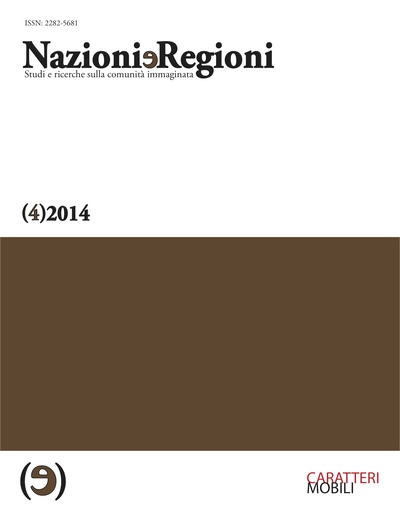Nazioni e postcolonialismo in Asia centrale vent'anni dopo: ripensare le categorie di analisi e le categorie della prassi
DOI:
https://doi.org/10.15162/2282-5681/1580Parole chiave:
Nazionalismo, postcolonialismo, Asia Centrale, Unione Sovietica, Kirghizistan, Uzbekistan, Tagikistan, Kazakistan, nationalism, postcolonialism, Central Asia, Soviet Union, Kyrgyzstan, Tajikistan, KazakhstanAbstract
A Sergej Abašin, uno dei maggiori studiosi russi dell’Asia Centrale, è capitato di trovarsi in Uzbekistan il 21 agosto 1991, giorno in cui a Mosca ebbe luogo il colpo di stato contro Gorbačëv. Tale esperienza lo ha indotto a fare propria la posizione simbolica di un osservatore esterno che però guarda agli eventi del 1991 da un punto di vista centroasiatico. Come afferma Abašin, la storia della frantumazione dell’Unione Sovietica e la sua interpretazione variano a seconda della prospettiva di osservazione. Il suo saggio è quindi un tentativo di dar conto del crollo dell’URSS tramite un’analisi delle trasformazioni avvenute nell’Asia Centrale postsovietica. Abašin mette in discussione l’universalità e la natura tautologica di tropi quali «nazionalismi locali», «nazionalismi delle élite locali» o «società postsovietiche». Egli mette in rilievo il fatto che in tutti i paesi della regione il processo di costruzione nazionale è ancora in corso ed è influenzato da particolari congiunture locali di molteplici fattori, non tutti ascrivibili ad un qualche «retaggio sovietico». Egli illustra le specificità di queste congiunture in Tagikistan, paese che fa appello alla propria diaspora e che è disperatamente in lotta contro l’alternativa islamica; in Kazakistan, paese in cerca di una formula di coesistenza con la sua comunità russa in Kirghizstan, paese che sta faticosamente cercando di preservare l’unità delle sue élite; e così via. Abašin fornisce delle ragioni per spiegare perché l’Uzbekistan sia diventato il paese-guida della desovietizzazione nella regione, e perché l’élite uzbeka utilizzi con estrema ostinazione una retorica postcoloniale. Infine l’autore nega validità all’applicazione all’Asia Centrale degli ultimi vent’anni di qualsiasi modello monologico di sviluppo, soprattutto se quest’ultimo pone l’accento sull’unicità di tale sviluppo.
One of the leading Russian specialists on Central Asia, Sergei Abašin happened to be in Uzbekistan on August 21, 1991. This experience inspired him to assume the symbolic position of an outside observer who nevertheless looks at the events of 1991 from the Central Asia perspective. As states, the breakup of the Soviet Union had its own history and interpretation depending on the point of observation. His essay is thus an attempt to make sense of the breakup of the USSR through an analysis of post-Soviet transformations in Central Asia. Abašin questions the universality and self-explanatory nature of such tropes as «local nationalisms», «nationalisms of local elites», or «post-Soviet societies». He stresses that the process of nation building continues in all countries of the region and is influenced by specific local conjunctures of multiple factors, not all of which can be traced to some «Soviet legacy». He illustrates the specifics of these conjunctures in Tajikistan, which appeals to its diaspora and desperately fights with the Muslim alternative; in Kazakhstan, which is searching for a formula of coexistence with its Russian community; in Kyrgyzstan, which is painfully trying to preserve the unity of its elites, and so on. He suggests reasons as to why Uzbekistan became the leader of de-Sovietization in the region, and why the Uzbek elite most persistently employs postcolonial rhetoric. Finally, he denies the validity of any monologic (post-Soviet, or postcolonial, etc.) model of development of Central Asia in the past twenty years, especially if such a model insists on the uniqueness of this development.
Riferimenti bibliografici
Abašin S. (2008), «Razmyšlenija o ‘Central’noj Azii v sostave Rossijskoj imperii’», Ab Imperio, n. 4, pp. 456-471.
Abašin S. (2009), «Mustakillik i pamjat’ ob imperskom prošlom: prokhodja po zalam taškentskogo Muzeja pamjati repressij», Neprikosnovennyj zapas, n. 4, pp. 37-54.
Adams L. (2009), «Primenima li kolonial’naja teorija k Central’noj Azii?», Neprikosnovennyj zapas, n. 4, pp. 25-36.
Adams L. (2010), The Spectacular State: Culture and National Identity in Uzbekistan, Duke University Press, Durham NC.
Baberowski J. (2003), Der Feind ist überall. Stalinismus im Kaukasus, DVA, München, 2003.
Edgar A. (2006), «Bolshevism, Patriarchy, and the Nation: The Soviet ‘Emancipation’ of Muslim Women in Pan-Islamic Perspective», Slavic Review, vol. 65, n. 2, pp. 252-272.
Haugen A. (2003), The Establishment of National Republics in Soviet Central Asia, Palgrave Macmillan, New York.
Heathershaw J. (2001), «Tajikistan amidst Globalization: State Failure or State Transforma- tion?», Central Asian Survey, vol. 30, n. 1, pp. 147-168.
Hirsch F. (2005), Empire of Nations: Ethnographic Knowledge and the Making of the Soviet Union, Cornell University Press, Ithaca NY-London.
Kandiyoti D. (2002), «Post-Colonialism Compared: Potentials and Limitations in the Middle East and Central Asia», International Journal of Middle East Studies, vol. 34, n. 2, pp. 279-297.
Khalid A. (2006), «Backwardness and the Quest for Civilization: Early Soviet Central Asia in Comparative Perspective», Slavic Review, vol. 65, n. 2, pp. 231-251.
Khalid A. (2007), «The Soviet Union as an Imperial Formation: A View from Central Asia», in Stoler A. – McGranahan C. – Perdue P. (eds.), Imperial Formations, School of Advanced Research Press, Santa Fe, pp. 123-151.
Kotkin S. (2001), «Novye vremena: Sovetskij Sojuz v mežvoennom civilizacionnom kontekste», in Charchordin O. (ed.), Michel Foucault i Rossija, Letnij Sad, Moskva-Sankt- Peterburg, pp. 239-314.
Martin, T. (2001), The Affirmative Action Empire: Nations and Nationalism in the Soviet Union, 1923–1939, Cornell University Press, Ithaca NY-London.
Megoran N. (2000), «Calming the Ferghana Valley Experts», Central Asia Monitor, n. 5, pp. 20-25.
Northrop D. (2004), Veiled Empire: Gender and Power in Stalinist Central Asia, Cornell University Press, Ithaca NY.
Petric B.-M. (2005), «Post-Soviet Kyrgyzstan or the Birth of a Globalized Protectorate», Central Asian Survey, vol. 24, n. 3, pp. 319-332.
Reeves M. (2005), «Locating Danger: Konfliktologiia and the Search for Fixity in the Ferghana Valley Borderlands», Central Asian Survey, vol. 24, no. 1, pp. 67-81.
Remnëv A. (2011), «Kolonial’nost’, postkolonial’nost’ i ‘istoričeskaja politika’ v sovremennom Kazachstane», Ab Imperio, n. 1, pp. 169-205.
Roy O. (2000), The New Central Asia: The Creation of Nations, I.B. Tauris, London.
Slezkine Yu. (1994), «The USSR as a Communal Apartment, or How a Socialist State Pro- moted Ethnic Particularism», Slavic Review, vol. 53, n. 2, pp. 414-452.
Smith G. – Law V. – Wilson A. – Bohr A. – Allworth E. (eds.) (1998), Nation-Building in the Post-Soviet Borderlands. The Politics of National Identities, Cambridge University Press, Cambridge.
Downloads
Pubblicato
Fascicolo
Sezione
Licenza
Nazioni e regioni è una rivista open access che applica la licenza Creative Commons CC BY-NC-ND 4.0 a tutti i contenuti pubblicati.
Nazioni e regioni is an open-access journal that applies the Creative Commons CC BY-NC-ND 4.0 licence to all published contents.







